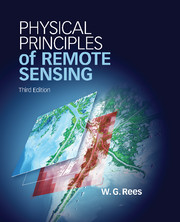Book contents
- Frontmatter
- Contents
- Preface
- Acknowledgements
- 1 Introduction
- 2 Electromagnetic waves in free space
- 3 Interaction of electromagnetic radiation with matter
- 4 Interaction of electromagnetic radiation with the Earth's atmosphere
- 5 Photographic systems
- 6 Electro-optical systems
- 7 Passive microwave systems
- 8 Ranging systems
- 9 Scattering systems
- 10 Platforms for remote sensing
- 11 Data processing
- Appendix Data tables
- References
- Index
- Plate Section
3 - Interaction of electromagnetic radiation with matter
Published online by Cambridge University Press: 05 December 2012
- Frontmatter
- Contents
- Preface
- Acknowledgements
- 1 Introduction
- 2 Electromagnetic waves in free space
- 3 Interaction of electromagnetic radiation with matter
- 4 Interaction of electromagnetic radiation with the Earth's atmosphere
- 5 Photographic systems
- 6 Electro-optical systems
- 7 Passive microwave systems
- 8 Ranging systems
- 9 Scattering systems
- 10 Platforms for remote sensing
- 11 Data processing
- Appendix Data tables
- References
- Index
- Plate Section
Summary
The interaction of electromagnetic radiation with matter is evidently fundamental to remote sensing. The subject is a vast one, embracing many areas of physics, and a fully systematic treatment of it would require at least a book in itself. In this chapter, therefore, we attempt to provide an overview that will be sufficient to gain an understanding of the operation of remote sensing systems. In order to keep the chapter to a manageable length, we reserve a discussion of the interaction of electromagnetic radiation with the Earth’s atmosphere to Chapter 4. Nevertheless, this is still a long chapter, and it is also the most technical in the book. It is not necessary to understand all of the material in this chapter in order to follow the subsequent material but, as usual, a reading of the summaries at the end of each section should give a general understanding of the material.
The chapter first extends some of the concepts of Chapter 2 into a consideration of how electromagnetic radiation propagates in homogeneous dielectric media. The key concepts here are the dielectric constant (also known as the relative electric permittivity) and the refractive index. By allowing these parameters to take complex, rather than purely real, values, the concept of absorption of radiation is included, and by allowing them to vary with frequency (or equivalently with wavelength) we are able to include the idea of dispersion, which will be important in Chapter 8 where we consider ranging systems.
- Type
- Chapter
- Information
- Physical Principles of Remote Sensing , pp. 42 - 109Publisher: Cambridge University PressPrint publication year: 2012



